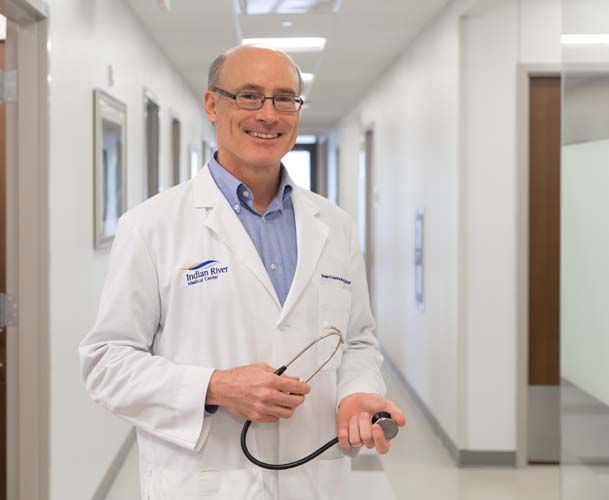“A comprehensive team approach,” says the Mayo Clinic, is the best way to help people who’ve been fighting – and losing – the battle of the bulge.
Starting this March that’s exactly what the Indian River Medical Center will be offering, with seven doctors working together to treat patients who need to lose weight for health reasons.
Dr. Gregory MacKay (pronounced mack-key), board-certified in both internal medicine and gastroenterology, offers details:
“We here at IRMC,” says MacKay, “are doing a comprehensive weight-loss program. We have our medical bariatric physician, Dr. Felice Haake, we have Dr. Theodore Perry, who does the bariatric surgery, and for those who don’t want to go into a major surgery with permanent changes to their anatomy, there’s the balloon option: a temporary bariatric balloon.”
That mirrors the Mayo Clinic approach which calls for “a team of medical experts, including endocrinologists, gastroenterologists, surgeons, dietitians and psychologists to help identify candidates who could most benefit from weight-loss surgeries or procedures.”
Mackay, one of four team members who will be doing the bariatric balloon procedures, lets his enthusiasm swell as he elaborates: “We are setting up the program now so that we’re ready to take people from day one, starting in March, and really help them maximize their weight loss and maximize them getting healthy. It’s more than just losing weight. It’s about getting healthy.”
For those deemed best suited for the bariatric balloon procedure, a connected pair of deflated balloons will be inserted by endoscope down the throat and into the stomach, where they will be filled with a saline solution that expands them to roughly the size of tennis balls. No incisions are made anywhere.
According to the FDA, the balloons do their work by “occupying space in the stomach,” which triggers a feeling of “fullness” so the patient doesn’t experience food cravings and therefore eats less.
Since the balloons can only stay safely inside the stomach for six months, the IRMC team’s biggest job is actually teaching and training people how to re-think their eating and exercise habits to maximize the period of reduced appetite.
And since this comprehensive weight loss program isn’t just a white-coated version of a TV lose-weight-fast plan, MacKay candidly points out that not everyone will be a candidate for the bariatric balloon procedure.
For starters, in order to qualify, patients need to have a body-mass index (or BMI, an estimate of body fat based on height and weight) of between 30 and 40, and at least one co-morbidity or health condition such as high blood pressure, type 2 diabetes or high cholesterol.
Moreover, Mackay says the gastric balloon treatment is “not covered by Medicare and private insurance. Bariatric surgery is and medical weight loss is in many cases,” but not the bariatric balloon procedure.
So what is the balloon cost likely to be? MacKay candidly says, “We haven’t made the final determination, but it may be in the $7,000 to $8,000 range.”
Patients do, however, get more than just a balloon in the belly for their seven grand.
According to MacKay, “they also get a Fitbit exercise tracker that records all their data on a daily basis so they know how they’re doing. There’s also a place where you do a food diary, a log of what you’re eating, so that you can really keep track of your progress. This is an everyday thing. Once you get into this program, it’s not like, ‘Here’s your balloon, good luck.’ You’re going to be busy. You’re going to be working at this [every day].”
The Fitbit use and a private patient “portal,” or secure online reporting destination, tips for healthy living, community forums, recipes and exercise ideas will be augmented by regular consultations with the medical team.
That, says MacKay, is important since he candidly points out, that for many people, “It’s not easy having a balloon in [their stomach], during the first week particularly.”
“The first week, your body is not used to it,” MacKay explains. “Most people have nausea, vomiting, abdominal pain or discomfort.” But that dissipates fairly quickly and creates that feeling of “fullness,” which lessens the urge to eat. MacKay and his fellow team members are anything but shy in explaining what lies ahead for their balloon patients.
With the proper precautions, including a regimen of acid-blockers and the elimination of certain stomach-irritating over-the-counter drugs such as Advil, Aleve and ibuprofen, the 20-minute outpatient balloon procedure can produce impressive results.
According to MacKay, “during the first six months, people lose between 25 and 40 percent of their excess body weight. So with a 200-pound woman, the average weight loss is 29 pounds.”
Dr. Gregory MacKay’s office is at 3450 11th Court, Suite 206 in Vero Beach. The phone number is 772-299-3511.

